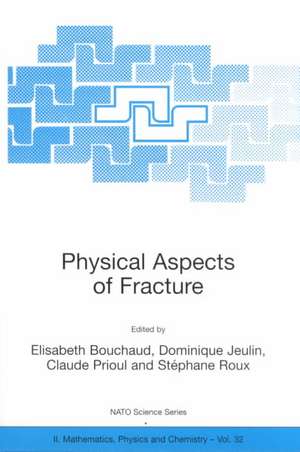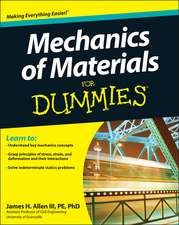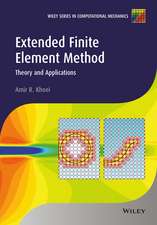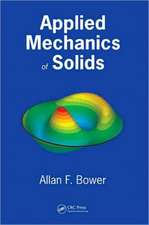Physical Aspects of Fracture: NATO Science Series II: Mathematics, Physics and Chemistry, cartea 32
Editat de Elisabeth Bouchaud, Dominique Jeulin, Claude Prioul, Stéphane Rouxen Limba Engleză Paperback – 31 aug 2001
Din seria NATO Science Series II: Mathematics, Physics and Chemistry
- 18%
 Preț: 1272.32 lei
Preț: 1272.32 lei - 15%
 Preț: 644.30 lei
Preț: 644.30 lei - 18%
 Preț: 1848.33 lei
Preț: 1848.33 lei - 18%
 Preț: 1235.76 lei
Preț: 1235.76 lei - 15%
 Preț: 649.87 lei
Preț: 649.87 lei - 18%
 Preț: 957.75 lei
Preț: 957.75 lei - 15%
 Preț: 656.58 lei
Preț: 656.58 lei - 18%
 Preț: 1235.43 lei
Preț: 1235.43 lei - 18%
 Preț: 960.13 lei
Preț: 960.13 lei - 18%
 Preț: 1225.79 lei
Preț: 1225.79 lei - 15%
 Preț: 666.41 lei
Preț: 666.41 lei - 18%
 Preț: 1835.07 lei
Preț: 1835.07 lei - 15%
 Preț: 640.71 lei
Preț: 640.71 lei - 18%
 Preț: 954.45 lei
Preț: 954.45 lei - 18%
 Preț: 1227.36 lei
Preț: 1227.36 lei - 15%
 Preț: 646.11 lei
Preț: 646.11 lei - 18%
 Preț: 948.61 lei
Preț: 948.61 lei -
 Preț: 400.10 lei
Preț: 400.10 lei - 18%
 Preț: 959.82 lei
Preț: 959.82 lei - 18%
 Preț: 944.19 lei
Preț: 944.19 lei - 18%
 Preț: 1838.38 lei
Preț: 1838.38 lei - 18%
 Preț: 1222.49 lei
Preț: 1222.49 lei - 18%
 Preț: 939.94 lei
Preț: 939.94 lei - 18%
 Preț: 950.66 lei
Preț: 950.66 lei - 18%
 Preț: 957.44 lei
Preț: 957.44 lei - 15%
 Preț: 656.74 lei
Preț: 656.74 lei
Preț: 400.85 lei
Nou
Puncte Express: 601
Preț estimativ în valută:
76.70€ • 80.09$ • 63.34£
76.70€ • 80.09$ • 63.34£
Carte tipărită la comandă
Livrare economică 15-29 aprilie
Preluare comenzi: 021 569.72.76
Specificații
ISBN-13: 9780792371472
ISBN-10: 079237147X
Pagini: 371
Ilustrații: XV, 371 p.
Dimensiuni: 160 x 240 x 22 mm
Greutate: 0.72 kg
Ediția:Softcover reprint of the original 1st ed. 2001
Editura: SPRINGER NETHERLANDS
Colecția Springer
Seria NATO Science Series II: Mathematics, Physics and Chemistry
Locul publicării:Dordrecht, Netherlands
ISBN-10: 079237147X
Pagini: 371
Ilustrații: XV, 371 p.
Dimensiuni: 160 x 240 x 22 mm
Greutate: 0.72 kg
Ediția:Softcover reprint of the original 1st ed. 2001
Editura: SPRINGER NETHERLANDS
Colecția Springer
Seria NATO Science Series II: Mathematics, Physics and Chemistry
Locul publicării:Dordrecht, Netherlands
Public țintă
ResearchCuprins
Opening overview (New trends in Fracture Mechanics).- Some studies of crack dynamics.- Brittle fracture.- Fracture of metals: Part I: Cleavage Fracture.- The Weibull law: a model of wide applicability.- Brittle fracture of snow.- Random fuse networks: a review.- On modelling of “winged” cracks forming under compression.- Continuum damage and scaling of fracture.- Damage of concrete: application of network simulations.- Degradation in brittle materials under static loadings.- Study of the brittle-to-ductile transition in ceramics and cermets by mechanical spectroscopy.- Ductile fracture.- Fracture of metals: Part II: Ductile Fracture.- Fracture mechanics of metals: some features of crack initiation and crack propagation.- A model of damage in an austenitic stainless steel by high temperature creep.- Interrelation between constitutive laws and fracture in the vicinity of friction surfaces.- Polycrystalline plasticity under small strains.- Fracture and mesoscopic plastic deformation.- Strain localization in single crystals and polycrystals.- Fatigue and stress corrosion.- Modelling in fatigue. Remarks on scales of material description: application to high cycle fatigue.- The influence of microstructure and moist environment on fatigue crack propagation in metallic alloys.- Cyclic strain localization in fatigued metals.- Environmental effects on fatigue in metals.- Stress corrosion of glass.- Dynamics of fracture.- Experimental challenges in the investigation of dynamic fracture of brittle materials.- Experiments in dynamic fracture.- Propagation of an interfacial crack front in a heterogeneous medium: Experimental observations.







